Yule Liu
ZPD-SCA: Unveiling the Blind Spots of LLMs in Assessing Students' Cognitive Abilities
Aug 20, 2025



Abstract:Large language models (LLMs) have demonstrated potential in educational applications, yet their capacity to accurately assess the cognitive alignment of reading materials with students' developmental stages remains insufficiently explored. This gap is particularly critical given the foundational educational principle of the Zone of Proximal Development (ZPD), which emphasizes the need to match learning resources with Students' Cognitive Abilities (SCA). Despite the importance of this alignment, there is a notable absence of comprehensive studies investigating LLMs' ability to evaluate reading comprehension difficulty across different student age groups, especially in the context of Chinese language education. To fill this gap, we introduce ZPD-SCA, a novel benchmark specifically designed to assess stage-level Chinese reading comprehension difficulty. The benchmark is annotated by 60 Special Grade teachers, a group that represents the top 0.15% of all in-service teachers nationwide. Experimental results reveal that LLMs perform poorly in zero-shot learning scenarios, with Qwen-max and GLM even falling below the probability of random guessing. When provided with in-context examples, LLMs performance improves substantially, with some models achieving nearly double the accuracy of their zero-shot baselines. These results reveal that LLMs possess emerging abilities to assess reading difficulty, while also exposing limitations in their current training for educationally aligned judgment. Notably, even the best-performing models display systematic directional biases, suggesting difficulties in accurately aligning material difficulty with SCA. Furthermore, significant variations in model performance across different genres underscore the complexity of task. We envision that ZPD-SCA can provide a foundation for evaluating and improving LLMs in cognitively aligned educational applications.
Evaluation Hallucination in Multi-Round Incomplete Information Lateral-Driven Reasoning Tasks
May 28, 2025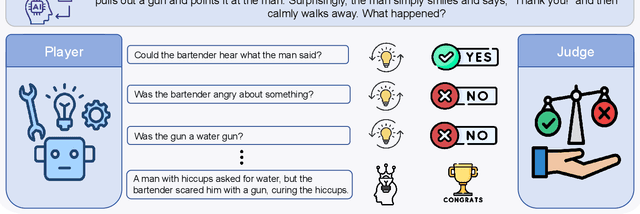


Abstract:Multi-round incomplete information tasks are crucial for evaluating the lateral thinking capabilities of large language models (LLMs). Currently, research primarily relies on multiple benchmarks and automated evaluation metrics to assess these abilities. However, our study reveals novel insights into the limitations of existing methods, as they often yield misleading results that fail to uncover key issues, such as shortcut-taking behaviors, rigid patterns, and premature task termination. These issues obscure the true reasoning capabilities of LLMs and undermine the reliability of evaluations. To address these limitations, we propose a refined set of evaluation standards, including inspection of reasoning paths, diversified assessment metrics, and comparative analyses with human performance.
JALMBench: Benchmarking Jailbreak Vulnerabilities in Audio Language Models
May 23, 2025


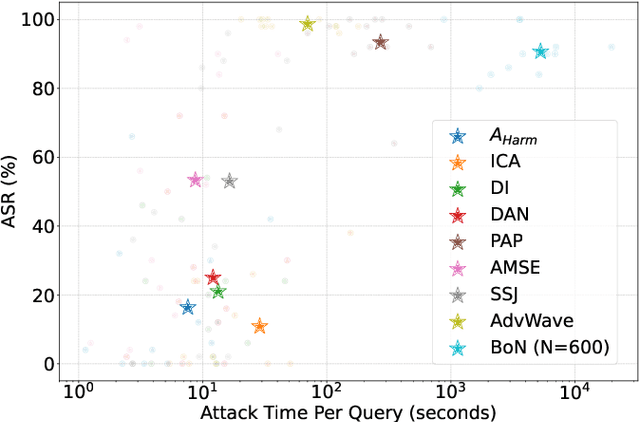
Abstract:Audio Language Models (ALMs) have made significant progress recently. These models integrate the audio modality directly into the model, rather than converting speech into text and inputting text to Large Language Models (LLMs). While jailbreak attacks on LLMs have been extensively studied, the security of ALMs with audio modalities remains largely unexplored. Currently, there is a lack of an adversarial audio dataset and a unified framework specifically designed to evaluate and compare attacks and ALMs. In this paper, we present JALMBench, the \textit{first} comprehensive benchmark to assess the safety of ALMs against jailbreak attacks. JALMBench includes a dataset containing 2,200 text samples and 51,381 audio samples with over 268 hours. It supports 12 mainstream ALMs, 4 text-transferred and 4 audio-originated attack methods, and 5 defense methods. Using JALMBench, we provide an in-depth analysis of attack efficiency, topic sensitivity, voice diversity, and attack representations. Additionally, we explore mitigation strategies for the attacks at both the prompt level and the response level.
Humanizing LLMs: A Survey of Psychological Measurements with Tools, Datasets, and Human-Agent Applications
Apr 30, 2025



Abstract:As large language models (LLMs) are increasingly used in human-centered tasks, assessing their psychological traits is crucial for understanding their social impact and ensuring trustworthy AI alignment. While existing reviews have covered some aspects of related research, several important areas have not been systematically discussed, including detailed discussions of diverse psychological tests, LLM-specific psychological datasets, and the applications of LLMs with psychological traits. To address this gap, we systematically review six key dimensions of applying psychological theories to LLMs: (1) assessment tools; (2) LLM-specific datasets; (3) evaluation metrics (consistency and stability); (4) empirical findings; (5) personality simulation methods; and (6) LLM-based behavior simulation. Our analysis highlights both the strengths and limitations of current methods. While some LLMs exhibit reproducible personality patterns under specific prompting schemes, significant variability remains across tasks and settings. Recognizing methodological challenges such as mismatches between psychological tools and LLMs' capabilities, as well as inconsistencies in evaluation practices, this study aims to propose future directions for developing more interpretable, robust, and generalizable psychological assessment frameworks for LLMs.
Thought Manipulation: External Thought Can Be Efficient for Large Reasoning Models
Apr 18, 2025Abstract:Recent advancements in large reasoning models (LRMs) have demonstrated the effectiveness of scaling test-time computation to enhance reasoning capabilities in multiple tasks. However, LRMs typically suffer from "overthinking" problems, where models generate significantly redundant reasoning steps while bringing limited performance gains. Existing work relies on fine-tuning to mitigate overthinking, which requires additional data, unconventional training setups, risky safety misalignment, and poor generalization. Through empirical analysis, we reveal an important characteristic of LRM behaviors that placing external CoTs generated by smaller models between the thinking token ($\texttt{<think>}$ and $\texttt{</think>)}$ can effectively manipulate the model to generate fewer thoughts. Building on these insights, we propose a simple yet efficient pipeline, ThoughtMani, to enable LRMs to bypass unnecessary intermediate steps and reduce computational costs significantly. We conduct extensive experiments to validate the utility and efficiency of ThoughtMani. For instance, when applied to QwQ-32B on the LiveBench/Code dataset, ThoughtMani keeps the original performance and reduces output token counts by approximately 30%, with little overhead from the CoT generator. Furthermore, we find that ThoughtMani enhances safety alignment by an average of 10%. Since model vendors typically serve models of different sizes simultaneously, ThoughtMani provides an effective way to construct more efficient and accessible LRMs for real-world applications.
The Rising Threat to Emerging AI-Powered Search Engines
Feb 07, 2025



Abstract:Recent advancements in Large Language Models (LLMs) have significantly enhanced the capabilities of AI-Powered Search Engines (AIPSEs), offering precise and efficient responses by integrating external databases with pre-existing knowledge. However, we observe that these AIPSEs raise risks such as quoting malicious content or citing malicious websites, leading to harmful or unverified information dissemination. In this study, we conduct the first safety risk quantification on seven production AIPSEs by systematically defining the threat model, risk level, and evaluating responses to various query types. With data collected from PhishTank, ThreatBook, and LevelBlue, our findings reveal that AIPSEs frequently generate harmful content that contains malicious URLs even with benign queries (e.g., with benign keywords). We also observe that directly query URL will increase the risk level while query with natural language will mitigate such risk. We further perform two case studies on online document spoofing and phishing to show the ease of deceiving AIPSEs in the real-world setting. To mitigate these risks, we develop an agent-based defense with a GPT-4o-based content refinement tool and an XGBoost-based URL detector. Our evaluation shows that our defense can effectively reduce the risk but with the cost of reducing available information. Our research highlights the urgent need for robust safety measures in AIPSEs.
SoK: Benchmarking Poisoning Attacks and Defenses in Federated Learning
Feb 06, 2025



Abstract:Federated learning (FL) enables collaborative model training while preserving data privacy, but its decentralized nature exposes it to client-side data poisoning attacks (DPAs) and model poisoning attacks (MPAs) that degrade global model performance. While numerous proposed defenses claim substantial effectiveness, their evaluation is typically done in isolation with limited attack strategies, raising concerns about their validity. Additionally, existing studies overlook the mutual effectiveness of defenses against both DPAs and MPAs, causing fragmentation in this field. This paper aims to provide a unified benchmark and analysis of defenses against DPAs and MPAs, clarifying the distinction between these two similar but slightly distinct domains. We present a systematic taxonomy of poisoning attacks and defense strategies, outlining their design, strengths, and limitations. Then, a unified comparative evaluation across FL algorithms and data heterogeneity is conducted to validate their individual and mutual effectiveness and derive key insights for design principles and future research. Along with the analysis, we frame our work to a unified benchmark, FLPoison, with high modularity and scalability to evaluate 15 representative poisoning attacks and 17 defense strategies, facilitating future research in this domain. Code is available at https://github.com/vio1etus/FLPoison.
Are We in the AI-Generated Text World Already? Quantifying and Monitoring AIGT on Social Media
Dec 24, 2024Abstract:Social media platforms are experiencing a growing presence of AI-Generated Texts (AIGTs). However, the misuse of AIGTs could have profound implications for public opinion, such as spreading misinformation and manipulating narratives. Despite its importance, a systematic study to assess the prevalence of AIGTs on social media is still lacking. To address this gap, this paper aims to quantify, monitor, and analyze the AIGTs on online social media platforms. We first collect a dataset (SM-D) with around 2.4M posts from 3 major social media platforms: Medium, Quora, and Reddit. Then, we construct a diverse dataset (AIGTBench) to train and evaluate AIGT detectors. AIGTBench combines popular open-source datasets and our AIGT datasets generated from social media texts by 12 LLMs, serving as a benchmark for evaluating mainstream detectors. With this setup, we identify the best-performing detector (OSM-Det). We then apply OSM-Det to SM-D to track AIGTs over time and observe different trends of AI Attribution Rate (AAR) across social media platforms from January 2022 to October 2024. Specifically, Medium and Quora exhibit marked increases in AAR, rising from 1.77% to 37.03% and 2.06% to 38.95%, respectively. In contrast, Reddit shows slower growth, with AAR increasing from 1.31% to 2.45% over the same period. Our further analysis indicates that AIGTs differ from human-written texts across several dimensions, including linguistic patterns, topic distributions, engagement levels, and the follower distribution of authors. We envision our analysis and findings on AIGTs in social media can shed light on future research in this domain.
On the Generalization Ability of Machine-Generated Text Detectors
Dec 23, 2024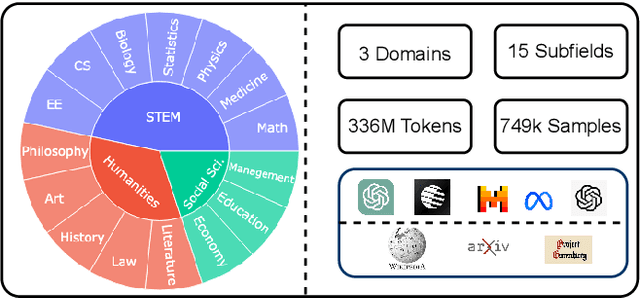
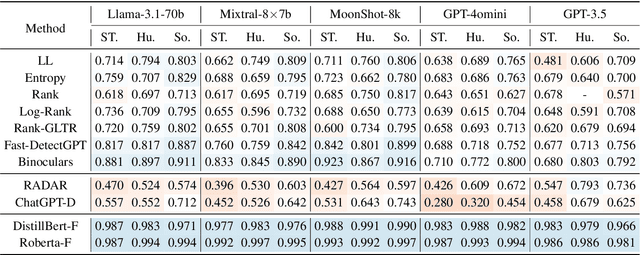

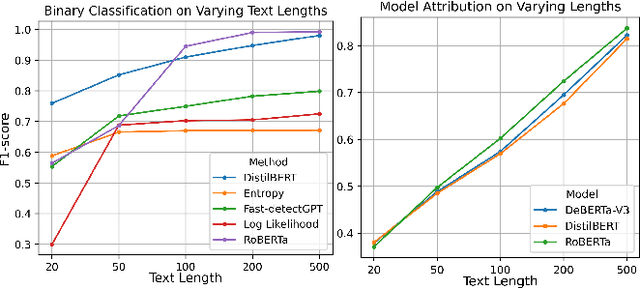
Abstract:The rise of large language models (LLMs) has raised concerns about machine-generated text (MGT), including ethical and practical issues like plagiarism and misinformation. Building a robust and highly generalizable MGT detection system has become increasingly important. This work investigates the generalization capabilities of MGT detectors in three aspects: First, we construct MGTAcademic, a large-scale dataset focused on academic writing, featuring human-written texts (HWTs) and MGTs across STEM, Humanities, and Social Sciences, paired with an extensible code framework for efficient benchmarking. Second, we investigate the transferability of detectors across domains and LLMs, leveraging fine-grained datasets to reveal insights into domain transferring and implementing few-shot techniques to improve the performance by roughly 13.2%. Third, we introduce a novel attribution task where models must adapt to new classes over time without (or with very limited) access to prior training data and benchmark detectors. We implement several adapting techniques to improve the performance by roughly 10% and highlight the inherent complexity of the task. Our findings provide insights into the generalization ability of MGT detectors across diverse scenarios and lay the foundation for building robust, adaptive detection systems.
Quantized Delta Weight Is Safety Keeper
Nov 29, 2024


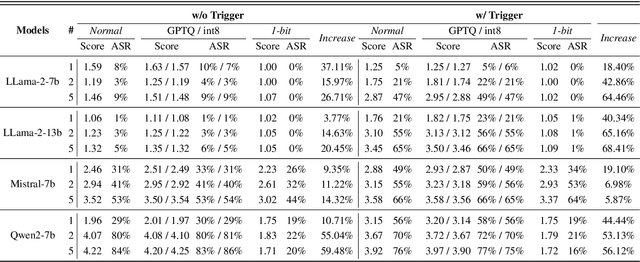
Abstract:Recent advancements in fine-tuning proprietary language models enable customized applications across various domains but also introduce two major challenges: high resource demands and security risks. Regarding resource demands, recent work proposes novel partial compression, such as BitDelta, to quantize the delta weights between the fine-tuned model and base model. Regarding the security risks, user-defined fine-tuning can introduce security vulnerabilities, such as alignment issues, backdoor attacks, and hallucinations. However, most of the current efforts in security assessment focus on the full-precision or full-compression models, it is not well-discussed how the partial compression methods affect security concerns. To bridge this gap, we evaluate the robustness of delta-weight quantization against these security threats. In this paper, we uncover a "free lunch" phenomenon: partial compression can enhance model security against fine-tuning-based attacks with bearable utility loss. Using Llama-2-7b-chat as a case study, we show that, with under 10% utility degradation, the partial compression mitigates alignment-breaking risks by up to 66.17%, harmful backdoor vulnerabilities by 64.46%, and targeted output manipulation risks by up to 90.53%. We further apply LogitLens to visualize internal state transformations during forward passes, suggesting mechanisms for both security failure and recovery in standard versus compressed fine-tuning. This work offers new insights into selecting effective delta compression methods for secure, resource-efficient multi-tenant services.
 Add to Chrome
Add to Chrome Add to Firefox
Add to Firefox Add to Edge
Add to Edge